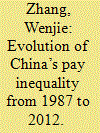|
|
|
Sort Order |
|
|
|
Items / Page
|
|
|
|
|
|
|
| Srl | Item |
| 1 |
ID:
139540


|
|
|
|
|
| Summary/Abstract |
Social development in Xinjiang Uyghur Autonomous Region from 1999 to 2009 is the focus of this article. I will explore the current situation among Uyghurs and Hans living in Xinjiang in different social contexts and purviews, mainly assessing problems and open questions hindering a balanced and consensus-based social development in the area. The concept of “development” per se will be understood with a critical perspective. The fieldwork was conducted in 2011 and 2012 in Urumqi, Turpan, Kahsgar, Wujiaqu and Shihezi, and in eight rural villages—seven located in the Kashgar Prefecture and one in Kizilsu Kyrgyz Autonomous Prefecture. The opportunity to adopt an “insider perspective”, at the same time working with critical tools provided by the disciplines of sociology and anthropology, can be considered an important asset in the field of Xinjiang studies. My PhD research in China (2010–2013) and my work as consultant for KFW (2011–2012) have been of great help in adopting this approach. Interviews, participant observation and analysis of quantitative and qualitative data from different sources are the basis of the fieldwork results presented here. UNDP indicators and indexes are taken as reference in setting and organising data.
|
|
|
|
|
|
|
|
|
|
|
|
|
|
|
|
| 2 |
ID:
147650


|
|
|
|
|
| Summary/Abstract |
This paper provides new estimates of the evolution of pay inequality in China, overall and also by region and sector, in the period from 1987 to 2012, using the between-group component of Theil’s T-statistic measured across regions and sectors. We find that China’s overall pay inequality started to rise rapidly in the early 1990s and that it peaked in 2008, with the between-province component peaking as early as 2002. Since 2008, overall pay inequality has decreased, with between-province and between-sector inequality both showing steady declines. We argue that China’s pay inequality during the reform period was not simply a matter of economic inequality; it was the joint product of both market and institutional forces. In this vein, we also argue that the recent decline of overall pay inequality after the 2008 global economic crisis was not a temporary phenomenon triggered by the global downturn, but a long-term outcome driven by both economic and policy factors.
|
|
|
|
|
|
|
|
|
|
|
|
|
|
|
|
| 3 |
ID:
126908


|
|
|
| 4 |
ID:
126338


|
|
|
|
|
| Publication |
2013.
|
| Summary/Abstract |
In 2011, more than 3% of all black men in the United States were imprisoned, compared to only 0.5% of all white men. Among prisoners ages 18 to 24, black men were imprisoned at a rate more than seven times that of white men (Carson and Sabol 2012). It is becoming increasingly urgent for researchers to understand what accounts for these race-based disparities. While a broad constellation of social problems exist that likely contribute to these disparities in concert, different fields of social science tend to focus on different types of explanations. Political scientists and sociologists have tended to emphasize the role of institutional factors, including criminal justice policies and practices, in maintaining race-based disparities. Social psychologists, in contrast, have tended to emphasize individual factors, including punitive responses to crime by jurors, judges, and criminal justice professionals.
|
|
|
|
|
|
|
|
|
|
|
|
|
|
|
|
|
|
|
|
|